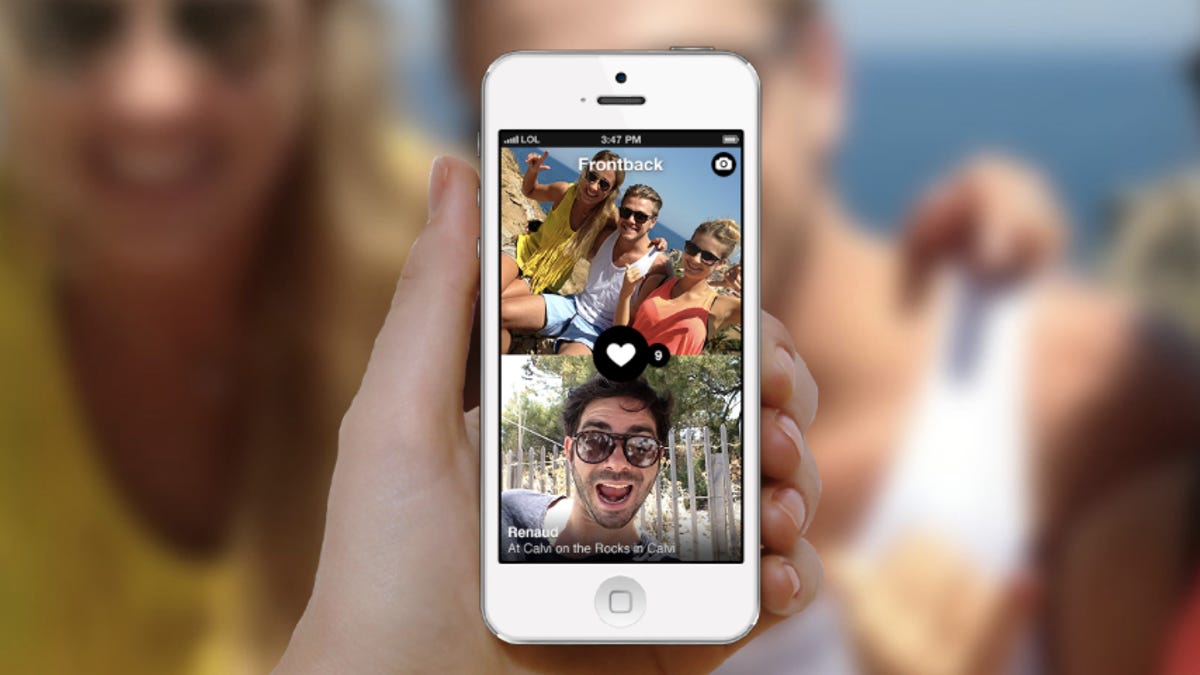With Frontback, there are two sides to every iPhone photo
Simple and fun, the one-month-old iPhone application has already been downloaded 200,000 times and is striking a cord with tech celebs.

Depending on who you talk to, Frontback, an iPhone app for snapping a pic from both your front and back cameras, is either the next novel idea in mobile photography or something too basic, too obvious to make it as a standalone app.
Launched one month ago, the Frontback app is exactly as it sounds. The application, which has been downloaded around 200,000 times, walks you through a three-step process where you take a pic with your back-facing camera, then one with your front-facing camera, and then save or share the composite image with friends or followers.
Simple though it may sound, Frontback has a few key early-adopter fans like Twitter inventor Jack Dorsey and his parents, former TechCrunch reporter and current Google Ventures partner M.G. Siegler, and YouTube star Justine Ezarik, better known by her Internet handle iJustine. The application also counts as adviser Instagram's former lead designer Tim Van Damme.
We like the same things. http://t.co/bmRItyP0dS #frontback pic.twitter.com/g6oA139CAv
— Jack Dorsey (@jack) August 21, 2013
Why so much tech-celeb attention for something that seems like just a silly feature that anyone, Facebook in particular, could easily copy? It's the simplicity that's inspiring creativity, co-founder Frédéric della Faille told CNET. Two photos are better than one at telling a story, he said.
The iPhone, unlike the Samsung Galaxy S4, which comes with "Dual Shot," doesn't allow for simultaneous front and back photo capture, but della Faille said he prefers the more manual way. People are using Frontback's back-then-front snap process to create ingeniously combined images.
"It's not just simply two pictures together, it's a new dimension," della Faille said.
Della Faille and the rest of the three-person team are also working on features to make the application a more compelling social-networking destination. Member profiles are in the works, as are ways to find and follow other users. Currently, application users auto follow their friends on Twitter, Facebook, and Instagram when they connect to those networks.
Reading this @parislemon http://t.co/02iRo5pvT1... http://t.co/gi3x9WTksN #frontback pic.twitter.com/HkNj2kDzwL
— brian pokorny (@brianp) August 20, 2013
Brian Pokorny, a partner at SV Angel, which holds a stake in the company behind the app, said that he's drawn to Frontback because, like Snapchat and Instagram, it fits into an overarching trend of people using less and less text to share emotion or tell a story.
Pokorny was the CEO of photo-sharing Web site DailyBooth and helped give birth to the beloved (and bemoaned) selfie. The service, popular with kids, missed the smartphone photo craze and later died off, but he sees potential in Frontback to push forward the photo trend, started by DailyBooth, of using self-portraits for communication, as opposed to taking pictures to preserve moments.
But Frontback, said Pokorny, is more than just the evolution of the selfie, it represents a new way to tell a short story.
"The camera can now take two pictures and two pictures can tell a story. Where you are, as much as who you're with, is a story," he said. "It's a very social photo experience."
Is Frontback the next Instagram? It's too soon to tell, but investors will soon pump an undisclosed sum of money into the application to ensure, at the very least, della Faille has the opportunity to grow the app into something big. The app amounts to a Hail Mary pass for della Faille's Checkthis, which went nowhere after raising around $1 million to develop a different social photo application for iPhone.
Easily replicable, Frontback already bears a striking resemblance to Dblcam, a predecessor in double-sided images. And with such a small idea, where can the app possibly go?
"Where it can go, I'm not sure," Pokorny said, "but the excitement I have around it are the characteristics that resemble other apps that started small and became big."

